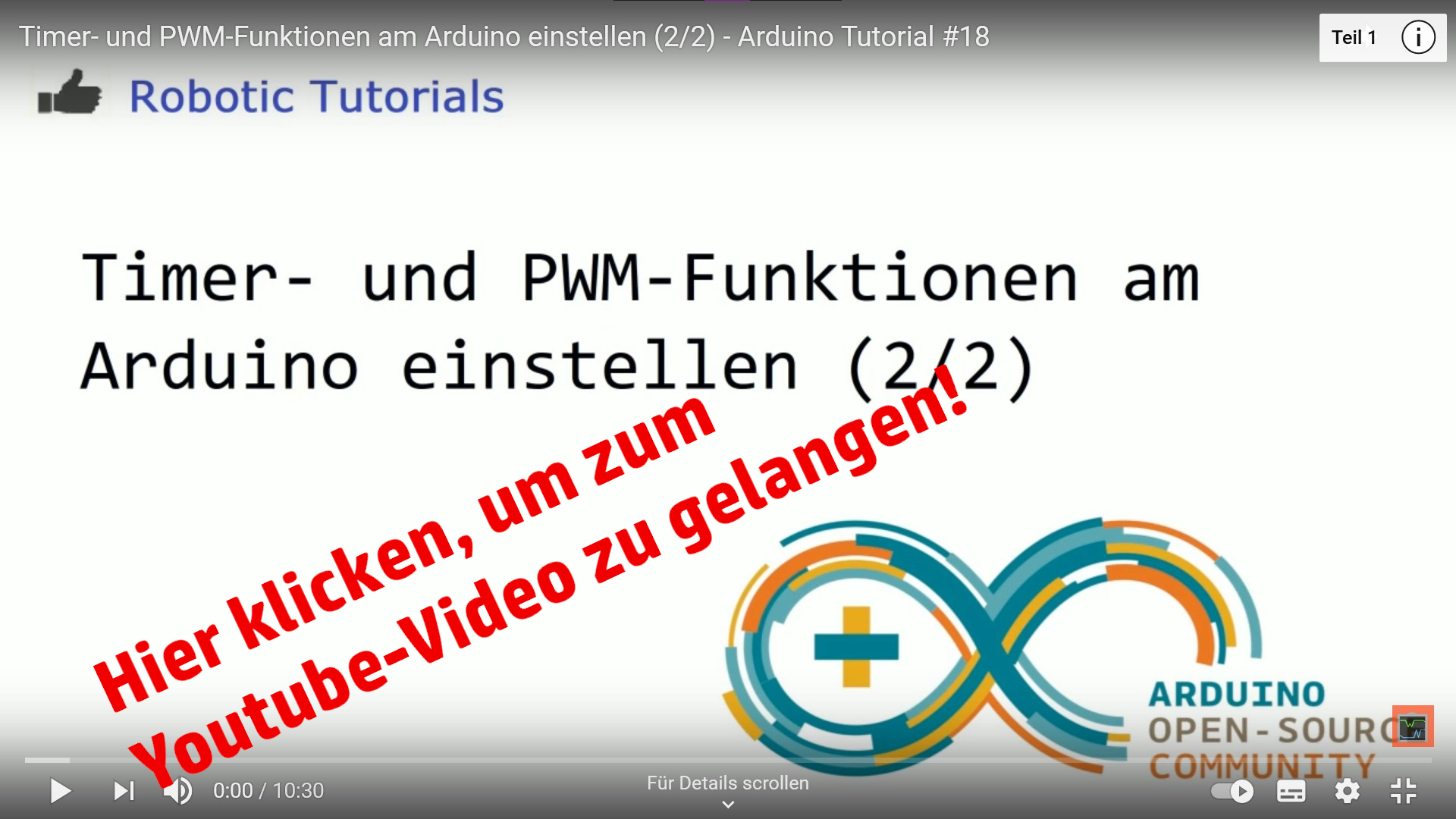Beispielprogramme - Timer-Funktionen
Hier sind die Beispielprogramme, die in den Youtube-Tutorials #17 und #18 zu den Timer-Funktionen verwendet wurden.
Du kannst entweder alle Programme auf einmal herunterladen, oder den Code anschauen und für dich passende Stellen rauskopieren.
Arduino-Programme herunterladen
1. Die Header-Datei “pwm.h”
class pwm{
private:
float Freq;
int Pin, selectParameters, dutyCycle;
String Mode;
public:
void setModeOut(int);
void setParameters(int);
void setFreq(float);
void setDC(int);
int getParameters();
float getFreq();
int getDC();
};
void pwm::setModeOut(int _Pin){
Pin = _Pin;
pinMode(_Pin, OUTPUT);
}
void pwm::setParameters(int _Parameter){
selectParameters = _Parameter;
}
void pwm::setFreq(float _Freq){
Freq = (float)_Freq;
}
void pwm::setDC(int _dutyCycle){
dutyCycle = _dutyCycle;
}
//
int pwm::getParameters(){
return selectParameters;
}
float pwm::getFreq(){
return Freq;
}
int pwm::getDC(){
return dutyCycle;
}
Video Teil 1/2:
2. Der Fast-PWM-Modus “1_Fast_PWM.ino”
/* By Robotic Tutorials
*
* Fast PWM Mode
*
* REGISTER : TCCR2A
* (1<<COM2A1) : Clear OC2A on compare match, set OC2A at BOTTOM,(non-inverting mode).
* (1<<COM2B1) : Clear OC2B on compare match, set OC2B at BOTTOM,(non-inverting mode).
* TOP Update of TOV Flag
OCRx at Set on
* (1<<WGM21) : Fast PWM 0xFF BOTTOM MAX
* (1<<WGM20) : Fast PWM 0xFF BOTTOM MAX
*
* Freq_Out = f_Clock/N*256 -> N: variable represents the prescale factor (1, 8, 32, 64, 128, 256, or 1024)
* -> f_Clock: For Arduino Uno 16MHz
*
* Duty_Cycle = (MAX+1)/256 -> MAX : The extreme values for the OCR2A/OCR2B register
*
* REGISTER: TCCR2B
* (1<<CS22) : clk T2S /64 (from prescaler)
*
*/
void setup() {
pinMode(3, OUTPUT);
pinMode(11, OUTPUT);
//TCCR2A = _BV(COM2A1) | _BV(COM2B1) | _BV(WGM21) | _BV(WGM20);
TCCR2A = (1<<COM2A1)| (1<<COM2B1) | (1<<WGM21) | (1<<WGM20);
/* Example 1: Freq_Out = 977Hz (Prescaler = 64 )
DC = 10%, DC = 85% */
//TCCR2B = _BV(CS22);
TCCR2B = (1<<CS22);
OCR2A = 25;
OCR2B = 216;
/* Example 2: Freq_Out = 7.8KHz (Prescaler = 8 )
DC = 50%, DC = 5% */
/*TCCR2B = (1<<CS21);
OCR2A = 126;
OCR2B = 11;*/
}
void loop() {
// put your main code here, to run repeatedly:
}
Video Teil 2/2:
3. Der Phase-Correct-PWM-Modus “2_Phase_Correct_PWM.ino”
/* By Robotic Tutorials
*
* Phase-Correct PWM
*
* REGISTER : TCCR2A
* (1<<COM2A1) : Clear OC2A on compare match, set OC2A at BOTTOM,(non-inverting mode).
* (1<<COM2B1) : Clear OC2B on compare match, set OC2B at BOTTOM,(non-inverting mode).
* TOP Update of TOV Flag
OCRx at Set on
* (1<<WGM20) : Fast PWM 0xFF BOTTOM MAX
*
* Freq_Out = (f_Clock/N*256)/2 -> N: variable represents the prescale factor (1, 8, 32, 64, 128, 256, or 1024)
* -> f_Clock: For Arduino Uno 16MHz
*
* Duty_Cycle = MAX/256 -> MAX : The extreme values for the OCR2A/OCR2B register
*
* REGISTER: TCCR2B
* (1<<CS22) : clk T2S /64 (from prescaler)
*
*/
void setup() {
pinMode(3, OUTPUT);
pinMode(11, OUTPUT);
TCCR2A = _BV(COM2A1) | _BV(COM2B1) | _BV(WGM20);
/* Example 1: Freq_Out = 488Hz (Prescaler = 64 )
DC = 40%, DC = 85% */
//TCCR2B = _BV(CS22);
TCCR2B = (1<<CS22);
OCR2A = 102;
OCR2B = 216;
/* Example 2: Freq_Out = 3.9KHz (Prescaler = 8 )
DC = 50%, DC = 25% */
/*TCCR2B = (1<<CS22);
OCR2A = 126;
OCR2B = 64;*/
}
void loop() {
// put your main code here, to run repeatedly:
}
04. Das Testprogramm “4_PWM.ino”
/*
* By : Rootic Tutorials
* Date : 05-11-2020
*
* The timer can either run from 0 to 255, or from 0 to a fixed value.
* (The 16-bit Timer 1 has additional modes to supports timer values up to 16 bits.)
* In the following "x" is "0", "1" or "2" for timer 0, 1 or 2.
*
* Freq_Out = (f_Clock/N*256)/2 -> N: variable represents the prescale factor (1, 8, 32, 64, 128, 256, or 1024)
* -> f_Clock: For Arduino Uno 16MHz
*
* Duty_Cycle = MAX/256 -> MAX : The extreme values for the OCR2A/OCR2B register
*
* Setting the timer prescaller:
* ---------------------------------------------------
* Setting Prescale_factor
* ---------------------------------------------------
* TCCRxB = _BV(CS01); // 1
* TCCRxB = _BV(CS11); // 8
* TCCRxB = _BV(CS10) | _BV(CS11); // 64
* TCCRxB = _BV(CS12); // 256
* TCCRxB = _BV(CS10) | _BV(CS12); // 1024
* ----------------------------------------------------
*
*
* For the Arduino UNO ->
* ------------------------------------
* Timer Output-Arduino Output
* ------------------------------------
* OC0A 6 PD6
* OC0B 5 PD5
* OC1A 9 PB1
* OC1B 10 PB2
* OC2A 11 PB3
* OC2B 3 PD3
* ------------------------------------
*
*
*/
/* Header Datei */
#include "pwm.h"
#define FCLOCK 16000000 // Clock Frequency
#define FCLOCKPLL 15625 // FCLOCK/1024
// PWM Pins
#define SIGNAL_PWM_ONE 9
#define SIGNAL_PWM_TWO 10
/* Variable to read incoming serial data */
int STATE = 0;
int16_t DC, DCValue;
int32_t FreqValue;
/* Defining an object of the PWM class */
pwm pwm1, pwm2;
/* Definition of functions */
void menuCfgActive();
void setFreqValue();
void setDCValue();
int32_t getFreqValue(int32_t _Freq);
void setup() {
/* Opens serial port, sets data rate to 9600 bps */
Serial.begin(9600);
Serial.setTimeout(10);
/* manual setup for 16 bit timer 1 with flexible PWM frequency */
// OCR1A/B/C inverting mode, timer mode 10, phase correct PWM, TOP set by ICR1
//TCCR1A = (1<<COM1A1) | (1<<COM1A0) | (1<<COM1B1) | (1<<COM1B0) | (1<<WGM11);
/* OCR1AB/B No inverting Mode, timer mode 16, phase correct PWM, TOP set by ICR1 */
TCCR1A = (1<<COM1A1) | (1<<COM1B1)| (1<<WGM11);
/* Display the initial menu on the serial monitor */
menuInit();
}
void loop() {
menuCfgSignal();
}
/* Functions */
/*
*@Description : Display the initial menu on the serial monitor
*/
void menuInit(){
Serial.println("----------------------------------------");
Serial.println("Hello to Robotic Tutorials");
Serial.println();
}
/*
*@Description : Configure the parameters of the PWM signal to be generated.
* In this case the Frequency and Duty Cycle
*
*@parameter[in]: None
*/
void menuCfgSignal(){
Serial.println("----------------------------------------");
Serial.println("Configure the parameters of the signals:");
Serial.println();
Serial.print("Frequency Value in Hz:");
while(Serial.available() == 0) {}
float FreqValue = Serial.parseFloat();
pwm1.setFreq(FreqValue);
Serial.print(pwm1.getFreq(),4);
Serial.print("\n");
// Duty Cycle Value in Register
Serial.read();
Serial.print("Duty Cycle of Signal 1");
Serial.print(" (in %) : ");
while(Serial.available() == 0) {}
DC = Serial.parseInt();
/* Checks if the value entered is valid */
if(DC > 0u && DC< 100)
{
pwm1.setDC(DC);
Serial.println(pwm1.getDC());
Serial.read();
}
else{
pwm1.setDC(0u);
Serial.println("Duty Cycle Error !");
}
Serial.print("Duty Cycle of Signal 2");
Serial.print(" (in %) : ");
while(Serial.available() == 0) {}
DC = Serial.parseInt();
/* Checks if the value entered is valid */
if(DC > 0u && DC< 100)
{
pwm2.setDC(DC);
Serial.println(pwm2.getDC());
Serial.read();
}
else{
pwm2.setDC(0u);
Serial.println("Duty Cycle Error !");
}
menuCfgActive();
int Option;
while(Serial.available() == 0) {}
Option = Serial.parseInt();
if(Option == 1){
// Frequeny Value in Register: Set PWM Value for OCR1A/B/C NO inverting mode to set the Duty Cycle
OCR1A = (getFreqValue(pwm1.getFreq()))*0.01*(pwm2.getDC());
OCR1B = (getFreqValue(pwm1.getFreq()))*0.01*(pwm1.getDC());
pinMode(SIGNAL_PWM_ONE, OUTPUT); // OCR1A
pinMode(SIGNAL_PWM_TWO, OUTPUT); // OCR1B
menuInit();
Serial.read();
}
else if(Option == 2){
Serial.read();
}
else if(Option == 3){
menuInit();
}
else{}
}
/*
*@Description : Calculate the TOP set by ICR1
* To obtain frequency values between 120mHz and 8MHz
*
* Freq_Out = (f_Clock/N*256)/2
* -> N: variable represents the prescale factor (1, 8, 32, 64, 128, 256, or 1024)
* -> f_Clock: For Arduino Uno 16MHz
*
* Duty_Cycle = MAX/256 -> MAX : The extreme values for the OCR2A/OCR2B register
*
*@parameter[in] : The Frequency value to be configurated
*@parameter[out]: The TOP set value (by ICR1)
*/
int32_t getFreqValue(float _Freq){
int16_t PrescalerValue = 0;
if(_Freq >= 123.0 && _Freq <= FCLOCK)
{
TCCR1B = (1<<WGM13) | (1<<CS10); // prescaler / 1
PrescalerValue = 1;
}
if(_Freq > 0.0 && _Freq < 123.0)
{
TCCR1B = (1<<WGM13) | (1<<CS10) | (1<<CS12); // prescaler / 1024
PrescalerValue = 1024;
}
else
{
/* Do Nothing */
}
ICR1 = (int32_t)(FCLOCK/PrescalerValue)/(2*_Freq);
return ICR1;
}
/*
*@Description : Select what to do
*/
void menuCfgActive(){
Serial.println("----------------------------------------");
Serial.println("What would you like to do?:");
Serial.println("(1) Turn ON Signals");
Serial.println("(2) Change Signals Configuration");
Serial.println("(3) Return to Initial Menu");
}
/* End of Programm 4_PWM , by Robotic Tutorials */


